I promised a final reckoning of my two-month residency in Basin Montana.
Here are a few stats: Jer and I were in Basin, population 255, from December 1 through January 28. I stopped painting January 22, having produced 70 paintings (not counting the ones I threw away). I painted 10 –14 hours a day, having little access to computers, no need to cook or clean, and the whole of Basin from which to work. The lowest temperature was 30 degrees below zero; the highest was 30 degrees above zero. I did one plein air watercolor.
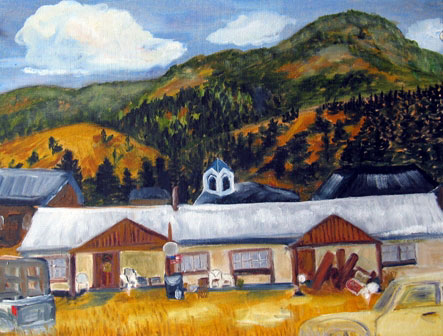
Brad’s Place
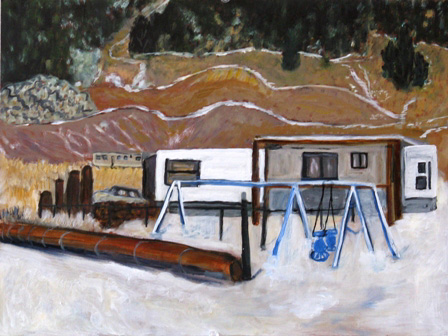
Mariah and Eli’s House
Observation #1: I got better at painting.
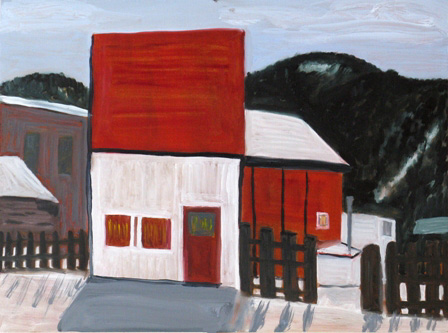
Teresa’s House
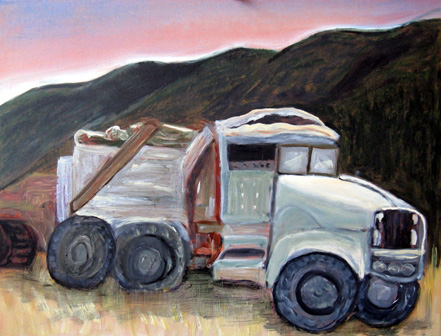
The Wrecking Yard Truck
Observation #2: For my work, fixing light and shadow in a painting can often fix the painting.
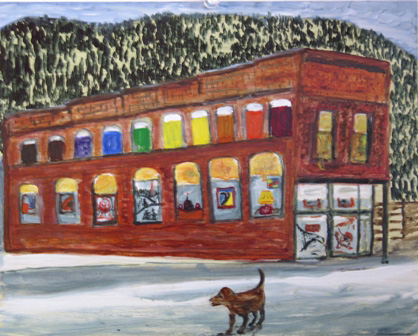
The Refuge in Reverse with Dog
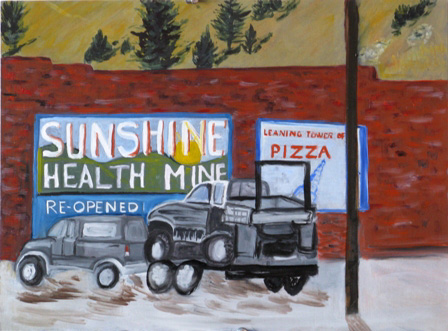
The Leaning Tower of Pizza with Truck and Trailer.
Observation #3: Just because you can paint mountains and pine trees doesn’t mean you can paint dogs and wheeled vehicles. “We must labor to be beautiful” (and also to paint as we want to, not as we can).
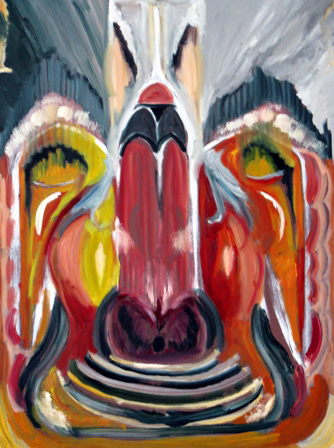
Portal: Mask
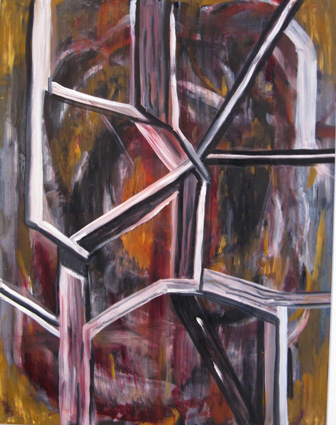
Portal: Barrier
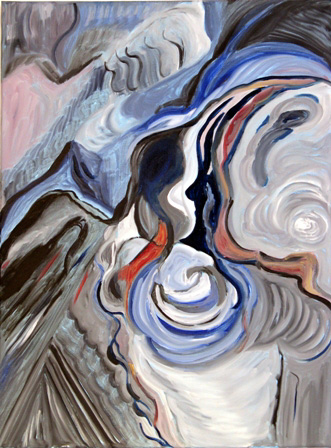
Portal: Silent Song

Portal: Frost
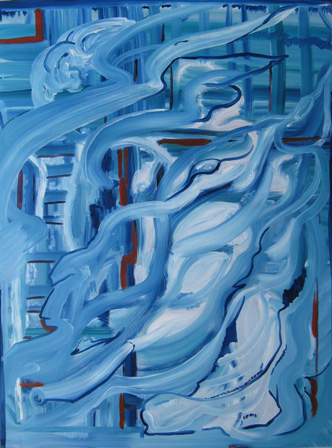
Portal: Going Home
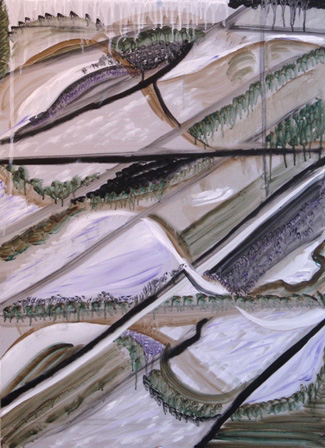
Portal: Travel
Observation #4: If I closely observe and paint the real, I can make leaps into the intuitive,the internal, the abstract.
The final exhibit showed many of the 70 paintings, hung in the Artists Refuge’s Hewitt Downstairs Studio. Out of those 70, I think the most important was “Refuge,” a 6 foot by 10 foot (approximately) set composed of 10 panels. It was on the back wall of the studio; the wall as well as the exhibit was titled “Basin in Winter: A Celebration of Place.”
In a couple of weeks, I’ll post on that specific set of paintings, trying to sort out how it both encapsulates what I was visualizing and also the meanings of what I painted. Stay tuned.

J.
Terrific.
Thanks, D.
We are back in Portland now and I’m suffering the letdown from this painting spree. I have to decide where I go from here, although since I haven’t unpacked the paintings yet, that might be a good start. It’s going to take a day or two to get connected again.
June,
That’s well over a painting a day, and I think you should count the ones you threw away. Do you think they were actually worth less to you as a painting (and therefore learning) experience?
What do you mean by getting better at painting? Did you feel more satisfied with your results? Get more naturalistic results? Make more leaps into the intuitive/internal/abstract?
I’m especially impressed with the portal series, I hadn’t realized it was that varied and extensive. The blizzardy “Going Home” is quite realistic; the highway was occasionally closed here and elsewhere while you were driving back.
June,
Here are my feelings about your paintings:
The order by which the images appeal to me.
Group I: (a) The Wrecking Yard Truck. I feel a great deal of humor and affection in this painting. The colors are great. The rising light above the mountains and the gleaming truck promise a wonderful day of exploration; (b) Teresa’s house; (c) Mariah and Eli’s House; (d) Brad’s place/The Refuge in Reverse with Dog/The Leaning Tower…
Group II: Overall favorite: Portal: Travel
I like (a) colors in Portal Barrier; (b) theme in Portal: Mask; (c) wildness in Portal: Silent Song; (d) precious, lacy wrappings in Portal: Frost
In Travel, the repetitive elements emphasize the length and monotony of the drive home. The colors are subtle and the lines great. I love the trees.
Initially, what caught my eyes were the blue (beautiful color) lines in the Silent Song. Looking closely, I felt a violence that I toned down by painting light grey over the whirling white in the foreground. That helped me see the structure to the left that appeals to me because of its lines and its color. The muted grey looks familiar from your textile art. Now, looking at it again what comes to my mind is the “Scream”. The whirling white and blue in the foreground seems more like a volcanic eruption than a Silent Song.
Looking at the Mask, the white lines in the center (church door?) were what caught my eyes initially. Again, toning them down with a grey brush brought out the contemplation in the unseeing eyes and the grey eyebrows and the lovely grey lines above them. I also appreciated the rest of the mask more consciously.
I like the emphasis that the White provides to the crispness of Teresa’s House. Here, the white is held down to earth by the horizontal lines of the red-orange roof. The extreme contrast of red/black/white is beautifully toned down by the pink/orange/grey hues.
In Mariah and Eli’s House, the white again harmonizes with the rest of the picture. It reminds me of a Hopper house. I also like the gleaming shine given by the white tones in ‘The Wrecking Yard Truck’ where I love the overall color scheme. I also like the White in the Portal: Barrier, and, mixed with pink, in the Portal: Frost. But, in Brad’s place, the white towers stick out looking like an owl.
Looking over my impression of the low-resolution photos of your images, it seems that some of your intense labor consisted of wrestling with White.
Adding to Travel: Harmony, Completion, Drive Home, Onwards.
Maybe, I am due for a cross country trip as my favorites are Truck and Road.
Steve,
As usual, you ask the most difficult questions, generally about comments I make that seem to me to be totally obvious <snort>.
Anyway, “better” means, I think, more able to achieve satisfactory results with reasonable effort. “Brad’s Place” is less than satisfactory to me, but took an enormous amount of time and effort.
Part of the “better” is “better at seeing what will work.” Both “Brad’s Place” and “Mariah and Ely’s House” were impossible at first glance — trashy elements, great expanses of natural detritus half snow-covered, un-elegant, un-romantic, un-harmonic structures against a wasted hillside — well, you get the idea. I didn’t want to wax critical or sarcastic, but the scene didn’t make appreciation easy.
In both cases, I was faced with the problem of painting what I felt no easy visual or meaningful relationship with.
I think I finally sorted through a variety of attributes of Brad’s place (the real thing). While it looked trashy, it was a place someone, presumably Brad, cared about. There was a birdhouse, a wreath on the front door, a big expensive barbeque, about 25 chairs, some of them actually usable, scattered around. It was hedged in by other trashy structures like an old school bus, which only makes sense in a very cold climate. It looked as if Brad and his friends had good times in warm weather, sitting open to the whole town over the expanse of chewed-up grass (there was actually a snow-covered lawn mower in the scene); I could imagine summer evening get-togethers, informal, bring over some hamburger and toss it on the grill; pull up a (slightly addled) lawn chair and sit a while, have a beer.
So Brad cared about what this heap of low rent housing looked like and lived like, which meant that somehow I should care, also. And then I started to see the various design elements in the scene — the rounded mountain, the school bell tower peering over the top of the structure, the lines of the trailers and the front expanse of space, the vehicles providing more horizontals.
The struggle with “Brad’s Place” (which I didn’t throw out, by the way) made doing Mariah and Ely’s easier. Mariah and Ely were young friends who requested that I paint their house, and Ely was particularly fond of the swing set and wanted it painted too. their house was also a trailer, with an unfinished tar-papered addition, sitting in front of the leavings of a strip mine, with an older trashed trailer behind it. The lawn was the usual winter mess — bits of unmown grass sticking out of dirty snow.
But in painting this scene, I eliminated side details, used the undulations of the talus slope to set off the strictly horizontal elements of the trailer and its half-finished addition and the swing set. The diagonal log helped give a bit of movement to the scene, although the movement might classically be defined as off-the-canvas, which is Not a Good Thing. However, on the whole, the feeling that Mariah and Ely’s house is being embraced by the slope behind it satisfied my desire to make the painting as scene of a home rather than a trailer.
So, “better” for me means better at achieving results with unhelpful material — achieving paintings that reflect both intentional design and intentional meaning given not naturally appealing subject matter.
The Portal series was miraculously easy after dealing with the unwieldy materials of my immediate surrounds in Basin. But it was dealing with the impossible elements of the town that allowed the abstract Portals to come so readily. So the struggle with the representational (or semi-rep) was essential.
This is almost certainly more than you wanted to know. And “Portal: Going Home” was done about a month ago — long before the snow really hit or we started to really think of leaving Basin. For me, it is a reflection of a kind of ambivalence about leaving my cocoon of work in Basin. I was feeling a bit homesick, but also not wanting to think about leaving. It reflects turmoil, which might have something of the blizzard about it. Blue is one of my least favorite colors, and is absolutely essential to this painting.
Birgit,
Wow– thank you for the extensive looking and thinking about the work. It’s enormously useful to me to hear this kind of close careful visual analysis.
You are right about white — it became almost a mantra for me. I became worried toward the end of my stay that I was going to use the entire large tube that I had available.
Photoshoping the white with gray is an interesting thought that had not occurred to me. I am planning on doing some computer-printed textiles from these paintings and will experiment with toning down the white just to see what I can see. This was the first time I used white so screamingly — but then I live in the gray Pacific Northwest. Basin really was whiter, even in its winter garb.
I don’t recommend travel at this time of the year, though. We spent one long day in a motel, waiting for one storm to pass so we could scrabble our way through the mountains before the next one hit. And the frozen slush from trucks was neither edifying nor useful — mostly it just increased my vocabulary….
Thanks, June, that was not too much at all. I’m always intrigued by the thought processes.
Like Birgit, I especially like Portal: Travel. Somehow the combination of horizontal and diagonal, along with your repetition of forms, really captures the feeling of traveling along through miles and miles of repeating scenery.
I think we too often look for the art experience as a representation of some Special Moment or as a product of a Cultivated Eye or Touch.
June’s work reminds me that our regular lives are really wonderfully irregular.
Ah June what you learned was how to “see”. Not only the visable, but also the sprit.
Barbara
June,
I LOVED seeing your paintings and reading about your residency! Enjoyed Jer’s photos as well.
I think the painting everyday allowed you to GROW as I see a change in your later paintings from your first ones.
Did you have to donate ones to the Refuge? If so, how did you chose?
What a FABULOUS grouping of paintings!!!
http://www.daleannepotter.com
D. and Barbara, thank you.
I learned through this experience that “place” — not the sublime, nor distant landscapes, nor wildly colored geologies — just the place I am in — is what fascinates me — visually, emotionally, and intellectually. I’m now planning on working Portland with my paints, as I have already spent time doing with my eyes and mind.
And Dale Anne, I wasn’t required to give any paintings to the Refuge. However, I was so grateful for the opportunity that it presented me with that on the last Open House, I had a sale of the paintings, all proceeds to the Refuge. I sold 14 paintings, which sounds great, until you realize that I priced them at rural Montana prices, with a 50% discount for Basin residents (no id required!). The total the Refuge garnered was about $400, but hey, that is $400 more than they had the day before. And I had a great time. Even the kids came around to buy Jer’s photos — and wouldn’t let me give them to them.
Thanks for checking in.